Approximately a week after the release of Ubuntu 11.04, I decided to upgrade my five PCs running Ubuntu or derivatives of Ubuntu to the latest release.
- Mythbuntu 10.10 to 11.04 (two PCs)
- Kubuntu (32-bit) 10.10 to 11.04
- Kubuntu (64-bit) 10.10 to 11.04
- Ubuntu (32-bit) 10.10 to 11.04
I was having a new bathroom fitted at the time so could spare a day to upgrade the PCs, as it turned out it took much longer than I thought!
Unfortunately there was an immediate set-back, the system hard disk on my FreeNAS server failed, I knew things were not right when it started making grating sounds on boot. I’ll be writing a separate article on how I fixed it and on the importance of backing up the FreeNAS config.xml file! So my upgrades were delayed by half a day whilst I sorted out my FreeNAS hardware.
I make it a standard practice to always backup my PCs using Clonezilla before embarking on any distribution upgrade. Although Linux is fairly “bullet-proof” when doing an upgrade, assuming you know what you are doing, there is always a risk of the unexpected happening, as I was about to discover.
Mythbuntu
MythPC1: MSI motherboard, Athlon 64 Socket AM2 3800, 2Gb RAM
MythPC2: ASUS motherboard, Athlon 64 Socket 939 4200 Dual Core, 2Gb RAM
This is my test Mythbuntu PC (MythTVPC1) and I had decided that I could afford to screw up the hard disk as I had a image on another after a hard disk upgrade.
I was delighted that this actually upgraded okay and the older image was not required!
I’ve since upgraded my main Mythbuntu (MythTVPC2) system and again the upgrade was flawless.
Verdict: 10/10 to the Mythbuntu team this is the upgrade experience every Linux user wants.
Kubuntu 64-bit
ASUS motherboard, Athlon 64 Socket AM2, 5200 Dual Core, 2Gb RAM)
Kubuntu detected that an upgrade was available, but failed to start the upgrade process
So decided to force the upgrade by entering in Terminal
sudo do-release-upgrade -d
This also failed and gave a message advising me to look at /var/log/dist-upgrade/, where I found the message below in red
2011-05-05 10:11:44,850 DEBUG nvidiaUpdate()
2011-05-05 10:11:44,860 ERROR NvidiaDetection returned a error: __init__() got an unexpected keyword argument ‘datadir’
2011-05-05 10:11:44,861 DEBUG Installing ‘dontzap’ (kubuntu-desktop PostUpgradeInstall rule)
2011-05-05 10:14:18,202 ERROR Dist-upgrade failed: ‘E:Unable to correct problems, you have held broken packages.’
2011-05-05 10:14:18,203 DEBUG abort called
2011-05-05 10:14:18,207 DEBUG openCache()
2011-05-05 10:14:18,207 DEBUG failed to SystemUnLock() (E:Not locked)
2011-05-05 10:14:25,471 DEBUG /openCache(), new cache size 32578
2011-05-05 10:14:25,472 DEBUG enabling apt cron job
Searching for “An unresolvable problem occurred while calculating the upgrade”
which suggested:
dontzap is holding back python and prevents the upgrade. Please remove it and try again.
So from terminal entered
sudo apt-get remove dontzap
Then did a normal upgrade using Kpackagekit, which part way through crashed out!
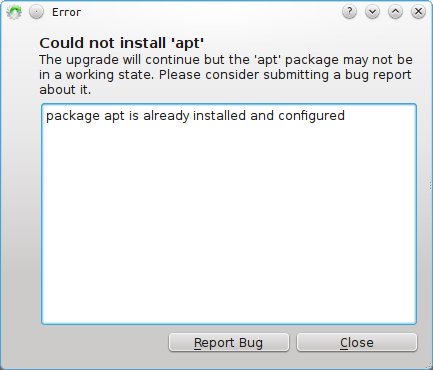
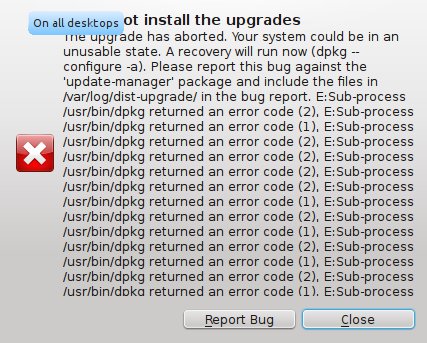
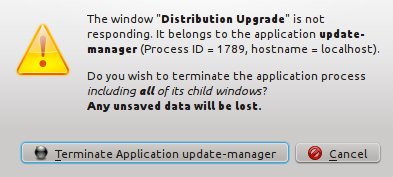
Killed KpackageKit using System monitor and reverted to doing the upgrade in Terminal.
Except I could not, so tried
sudo apt-get -f install
Which produced the following
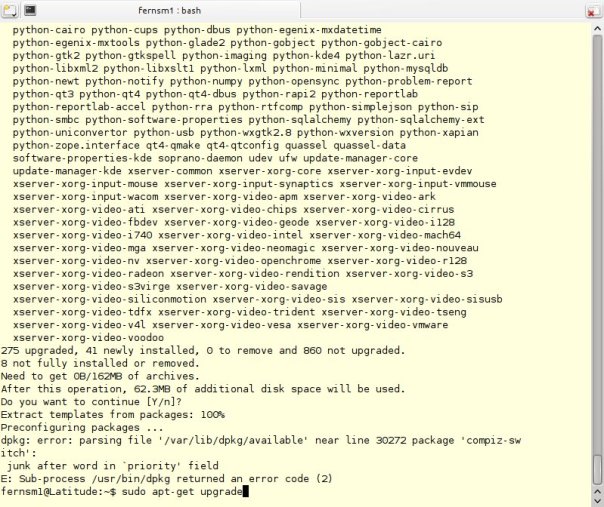
A quick search on dpkg: parse error, in file ‘/var/lib/dpkg/available’ found https://answers.launchpad.net/ubuntu/+question/10265
Entered
sudo dpkg –clear-avail
then
sudo apt-get update followed by
sudo apt-get upgrade
and the upgrade continued.
Then did another
apt-get update
apt-get upgrade
then did a
apt-get update
apt-get dist-upgrade
Then got messge “errors were encountered processing” bluefish-data and bluefish-pluginser experience I would score you 3/10 and 4/10 respectively.

entered sudo apt-get -f install and the upgrade continued.
It then crashed out “not using locking for read only lock file /var/lib/dpkg/lock
Tried deleting the lock file using sudo but got error back
cannot remove read only file system. Also could not save screenshots to my home folder, same error.
As generic linux headers had been setup decided on a reboot to see what I got!
On reboot Linux found disk errors which it fixed and then booted into the login screen. [see screenshots].
apt-get upgrade
On login opened up terminal and entered[see screenshots].
sudo apt-get update
which told me that dpkg was interrupted and to run sudo dpkg –configure -a, which I did.
The upgrade process resumed and completed successfully.
Then did sudo apt-get autoremove to clean up redundant packages
Verdict: 3/10 this is the upgrade experience every Linux user could do without!
Kubuntu 32-bit
Dell Latitude C640 laptop, P4M 2.4GHz, 1Gb RAM
Kubuntu refused to recognise that an upgrade to 11.04 existed, so decided to force the upgrade the "old way" by entering
sudo do-release-upgrade -d
then got the error
trying to overwrite ‘/usr/share/kde4/config/khtmlrc’, which is also in package libkdecore5 4
Installation aborted, rerunning KpackageKit caused it to crash had to Kill it!.
And system requested a restart.
Ignored the system restart request, as this is a good way to kill the installation, so instead continued the upgrade using Terminal by entering
apt-get update
apt-get upgrade
Got into dependency problem due to the failed installation
so did a:
sudo apt-get -f install
This resumed the installation
Then another
apt-get update
apt-get upgrade
and continued the upgrade
Got the “Configuring ttf-mscorefonts-installer” screen
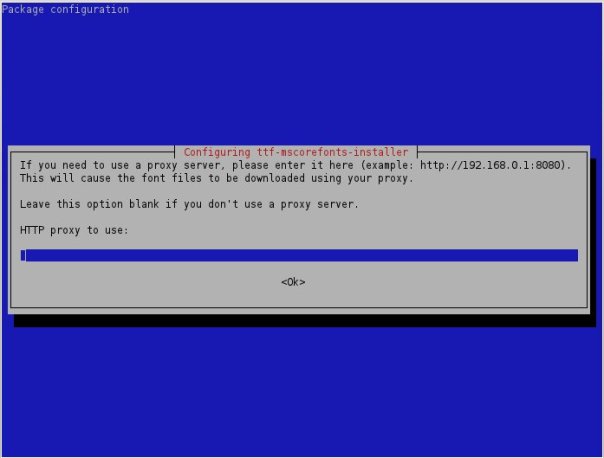
Left blank, selected OK then enter and nothing happened. Repeated about 20 times before it accepted OK. Weird!
Installation then completed shortly afterwards.
Did another
apt-get update
apt-get upgrade
and got message saying 167 packages had been kept back
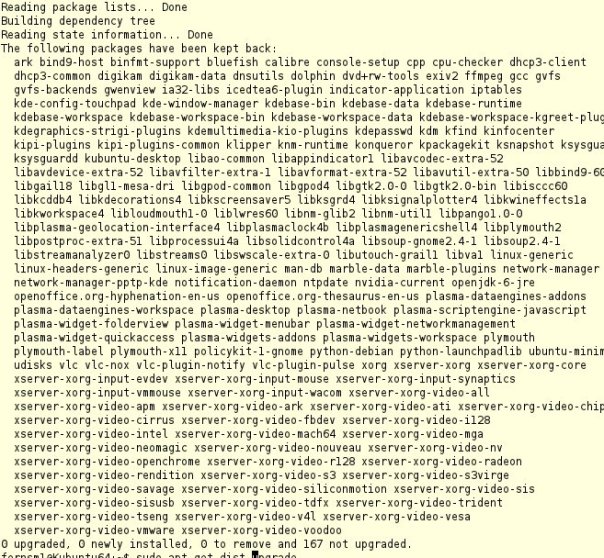
Entered
apt-get dist-upgrade
The another
sudo apt-get -f install
sudo apt-get autoremove
A reboot later and…….
I had a fully upgraded (and working) system.
Verdict: 3/10 this is the upgrade experience every Linux user could do without!
Kubuntu 11.04 – The Bottom Line
I really like KDE4 and what the developers have done over the past two years. However, whilst it is very user friendly, the upgrade process to 11.04 has been nothing short of a complete nightmare.
Unless KPackageKit can be made to work 99.9% reliably and should it go wrong the user gets meaningful and useful information on how to resolve, maybe it goes off and puts the error message into a web search, then the developers should give up and advise users to use Terminal, because this is the most reliable way of doing an upgrade as it is more flexible when something goes wrong.
It should not be a necessary requirement to have a second computer on standby with access to the internet to find solutions to error messages which are generated as a result of the upgrade and without you are likely to end up with a broken system. If the upgrade fails part way through the system should create a log file, dump relevant information into it and then roll-back to a known working state. The log file should then be displayed to the user so they can establish by a web search what went wrong and how to fix. On restarting the upgrade it should resume the upgrade.This should apply to ALL Linux distribution upgrades, not just Kubuntu.
Based on my really poor upgrade experience to 11.04, all I can conclude is that KpackageKit is really a very poor relation to Ubuntu’s Update Manager and until something is done to make it better, I will be doing all my future upgrades using Terminal, if only to avoid some of this unnecessary pain.
Ubuntu 32-bit
Gigabyte motherboard, Athlon 64 Socket AM2, 5600 Dual Core, 4Gb RAM)
No problem starting the upgrade and it was going well when it totally hung on “Setting up libdu0(2.32.1-0 ubuntu4)"
With no choice available, I rebooted the PC into recovery console and selected repair broken packages DPKG
Logged in from the command line as X had not started.
Did a sudo-apt-get autoremove as suggested as part f the broken package repair
entered startx, which then asked for password for the keyring
The first problem, no menu bar on the Ubuntu desktop and ALT-F2 did not work.
After a couple of reboots, I eventually got a login screen and successfully logged in. I have to say that I came very close to doing a restore!
I then realised that my Gnome desktop had changed, it looked like the new GNOME3 interface, but different!
Eventually discovered it was the new Ubuntu interface, nice to have been told but I assume because of the broken upgrade Ubuntu defaulted to it new desktop interface by default. Now being a former KDE3 user I accepted KDE4 as an improvement to the interface and now a few years on absolutely love it. The new Ubuntu interface is terrible, so after two days switched back to the Classic Ubuntu interface. I don’t mind change but it has to be for a good reason and at this point in time in Ubuntu Gnome is my preferred interface not Ubuntu!
Verdict: 4/10 this is the upgrade experience most Linux users could do without!
Conclusion
Whilst I’m critical of the Kubuntu 11.04 upgrade process, I’m almost equally critical of Ubuntu. I’ve never experienced so many problems across most of my computers upgrading an Ubuntu distribution and I’ve been doing this for over 5 years!
The only Ubuntu variant which has upgraded to 11.04 without any problems is the XFCE based Muthbuntu, on which I run two PCs so this was not a one off but of good luck. So to the Mythbuntu Team for user experience 10/10.
To the Kubuntu and Ubuntu teams if you wish to keep new users using your distribution, this sort of experience is definitely not the way to go!
Finally, if you are thinking of upgrading based on your past experience of upgrading Ubuntu 11.04 then:
1. Think twice!
2. Make sure you have a second PC which you can use to connect to the Internet when things go wrong
3. If you do not normally clone your system before upgrading, think twice! Make sure that on this occasion you backup your computer with Clonezilla or similar before starting the upgrade.
4. When Ubuntu 11.10 comes out proceed with caution. I would like to think the upgrade process will be fixed by then but as they say "time will tell".
=-=-=-=-=
Powered by Blogilo
What a mess!
Sorry you had a hard time with Ubuntu. The Mint Linux community has gathered quite a few who hated the Unity interface
As you might know, Mint Linux is derived from Ubuntu, and uses many Ubuntu repositories.
I’ve been running Mint 11 Gnome for a while; it worked well, until the keyboard went dead when I tried to log in. Should have fixed it when my Dvorak keymap was not sticky, and I couldn’t change the password. My machine is an Athlon 64 single-core, 2.2 GHz, 1 GB RAM shared with video on the motherboard. I had tried out Mint 12: 12 KDE was simply hopeless; endless waits for disk accesses to finish. 12 Gnome was a serious effort to improve upon Unity, and it worked, but was a bit too Spartan. I decided to reinstall 11 Gnome (named Katya), expecting a happy stable OS. Used the Katya live CD, but when I tried to do the DVD upgrade, something quite-weird happened, and I got the error message “Can not install ‘mint-meta-gnome-dvd’ (E:Unable to correct problems, you have held broken packages.)”
I have tried sequences of [apt-get] commands, Synaptic’s “Fix broken packages”; none worked. Apparently, gvfs (something “behind the scenes”) enables apps. to look at any spinning HDs connected to the machine — any partitions. Okay, so I apparently left some cruft when that weirdness happened. I offloaded /home to another drive, using the [dd] command, and disconnected the drive. I deleted the partitions that had other Mint versions,
and even created this present one from unallocated space. I installed Katya once again, and am still getting this error! If there are files on the disc, perhaps gvfs reads them, anyhow.
It seems routine for Mint, and maybe Ubuntu, to pay attention to files in other partitions, and conceivably even files left over from deleted partitions.
I’m beginning to think I’m the victim of a significant hack (virus? rootkit?), and am about ready to store zeros in the whole 500 GB drive (overnight?). (Mint doesn’t have /dev/null).
The persistence of this error message is almost horrifying! It’s almost as if its cause had been stored in my BIOS, but that’s almost too weird to consider. (I did, however, have one successful upgrade run when I was running as a live CD.)
Hope this message serves some useful purpose; please don’t be too reluctant to delete it.
It seems that there are a number of people experienceing this sort of problem with the DVD edition. I’ve had a quick look at the Mint forums, you might find this post http://forum.linuxmint.com/viewtopic.php?f=90&t=95034&p=544699 helpful.
I don’t thinkg you have a virus or have been hacked and I doubt if the BIOS has been compromised.
I use Linux Mint myself on a few PCs, I run Mint 12 on an eee PC 1005HA and it runs really well. I like GNOME 3 for me a big improvement over GNONE 2, but there again I also like KDE 4 (although I’ve never tried this in Mint I stick with Kubuntu).
The only problem I have had so far with Mint 12 is that on my HP laptop (P4M cpu 1Gb RAM), I have failed to get it to install and an upgrade from 11 also failed. So for the time being I’ll stick to Mint 11 on this computer.
Ubuntu Unity – I don’t know what it is but I don’t like the interface (I think it’s the icons) too chunky.